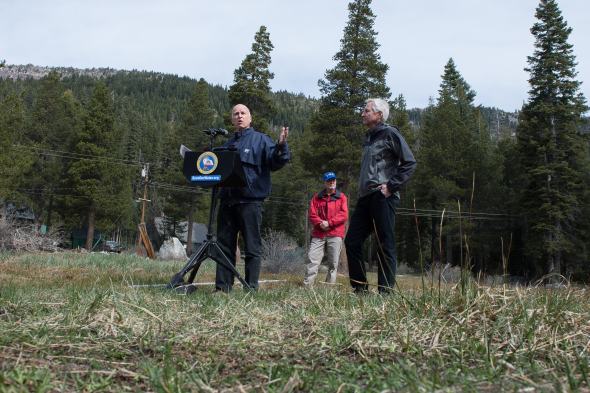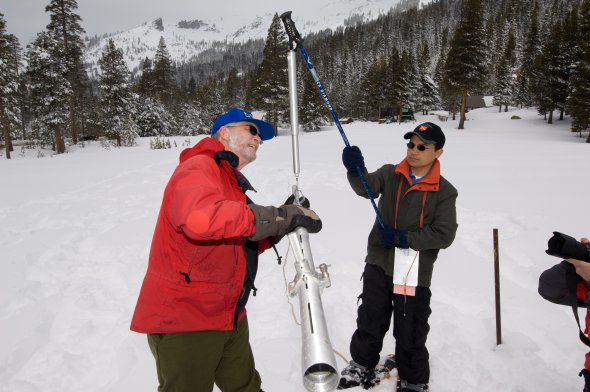California Snowpack Is Virtually Gone

The California Department of Water Resources found no snow during its manual survey in the Phillips snow course in the Sierra Nevada mountain range. Governor Edmund G. Brown Jr. (left) observed the survey, which confirmed electronic readings showing the statewide snow pack with less water content today than any April 1st since 1950.
Photo courtesy of the California Department of Water Resources
California state hydrologists went to take their annual early-April measurement Wednesday of how much snow was in the Phillips snow course, but they faced an unusual problem: There was no snow to measure.
The California Department of Water Resources (DWR) found no snow whatsoever Wednesday during its manual survey for the media at 6,800 feet in the Sierra Nevada mountain range, which essentially serves as the state’s long-term water storage.
This was the first time in 75 years of early-April measurements at the Phillips snow course that no snow was found there.
Governor Edmund G. Brown Jr. observed the survey, which confirmed electronic readings showing the statewide snowpack with less water content today than any April 1st since 1950.
Attending the survey with Governor Brown was DWR Director Mark Cowin, who said Californians can expect to receive almost no water from the meager snowpack as it melts in the coming weeks.
“Today’s survey underscores the severity of California’s drought,” he said. “Water conservation must become a way of life during the worst drought in most Californians’ lifetimes.”
Mandatory Cuts
Following the lowest snow pack ever recorded and with no end to the drought in sight, Governor Brown announced actions that will save water, increase enforcement to prevent wasteful water use, streamline the state’s drought response, and invest in new technologies that will make California more drought resilient.
“Today we are standing on dry grass where there should be five feet of snow. This historic drought demands unprecedented action,” Brown said. “Therefore, I’m issuing an executive order mandating substantial water reductions across our state. As Californians, we must pull together and save water in every way possible.”
For the first time in state history, the governor has directed the State Water Resources Control Board to implement mandatory water reductions in cities and towns across California to reduce water usage by 25%. This savings amounts to approximately 1.5 million acre-feet of water over the next nine months, or nearly as much as is currently in Lake Oroville.

This photo, which was taken five years earlier in Philips snow course, shows a much different situation regarding the snow pack.
Photo courtesy of the California Department of Water Resources
Agricultural water users – which have borne much of the brunt of the drought to date, with hundreds of thousands of fallowed acres, significantly reduced water allocations and thousands of farmworkers laid off – will be required to report more water use information to state regulators, increasing the state’s ability to enforce against illegal diversions and waste and unreasonable use of water under Wednesday’s order.
To save more water now, the order will also:
- Replace 50 million square feet of lawns throughout the state with drought tolerant landscaping in partnership with local governments.
- Direct the creation of a temporary, statewide consumer rebate program to replace old appliances with more water- and energy-efficient models.
- Require campuses, golf courses, cemeteries, and other large landscapes to make significant cuts in water use.
- Prohibit new homes and developments from irrigating with potable water unless water-efficient drip irrigation systems are used, and ban watering of ornamental grass on public street medians.
Historically Significant
Wednesday’s readings are historically significant, since the snowpack traditionally is at its peak by early April before it begins to melt. Electronic readings today found that the statewide snowpack holds only 1.4 inches of water content, just 5% of the historical average of 28.3 inches for April 1.
The previous low for the date was 25% in 2014 and 1977. The Phillips snow course, which has been surveyed since 1941, has averaged 66.5 inches in early-April measurements there. Four years ago today, the measured depth at Phillips was 124.4 inches. The deepest April 1st Phillips measurement was 150.7 inches in 1983, and the lowest previously was 1.04 inches in 1988.
Electronic readings indicate the water content of the northern Sierra snowpack today is 1.4 inches, 5% of average for the date. The central and southern Sierra readings were 1.5 inches (5% of average) and 1.3 inches (5%), respectively.
Today’s manual survey was the fourth of the season conducted for the news media at the Phillips snow course just off Highway 50, 90 miles east of Sacramento. When DWR conducted the first three manual surveys on Dec. 30, Jan. 29 and March 3, the statewide water content in the snowpack was 50%, 25%, and 19%, respectively of the historical averages for those dates.
The decline reflects California’s significantly lower precipitation and the warming trend that made this winter the warmest in the state’s recorded history. What precipitation there was fell mostly as rain due to warmer temperatures.
In what were considered normal precipitation years, the snowpack supplied about one-third of California’s water needs as it melts in the spring and summer. The greater the snowpack water content, the greater the likelihood California’s reservoirs will receive ample runoff as the snowpack melts to meet the state’s water demand in the summer and fall.
Little precipitation has fallen in Northern California since early February. California’s historically wettest winter months have already passed, and the drought is now firmly rooted in its fourth consecutive year.
Increasing Enforcement
The governor’s order calls on local water agencies to adjust their rate structures to implement conservation pricing, recognized as an effective way to realize water reductions and discourage water waste.
Additionally, the governor’s action strengthens standards for agricultural water management plans submitted by large agriculture water districts, and requires small agriculture water districts to develop similar plans. These plans will help ensure that agricultural communities are prepared in case the drought extends into 2016.
Additional actions required by the order include:
- Taking action against water agencies in depleted groundwater basins that have not shared data on their groundwater supplies with the state.
- Updating standards for toilets and faucets and outdoor landscaping in residential communities and taking action against communities that ignore these standards.
- Making permanent monthly reporting of water usage, conservation, and enforcement actions by local water suppliers.
Streamlined Response
The order also:
- Prioritizes state review and decision-making of water infrastructure projects and requires state agencies to report to the Governor’s Office on any application pending for more than 90 days.
- Streamlines permitting and review of emergency drought salinity barriers – necessary to keep freshwater supplies in upstream reservoirs for human use and habitat protection for endangered and threatened species.
- Simplifies the review and approval process for voluntary water transfers and emergency drinking water projects.
- Directs state departments to provide temporary relocation assistance to families who need to move from homes where domestic wells have run dry to housing with running water.
Sources: California Department of Water Resources, California Office of the Governor










